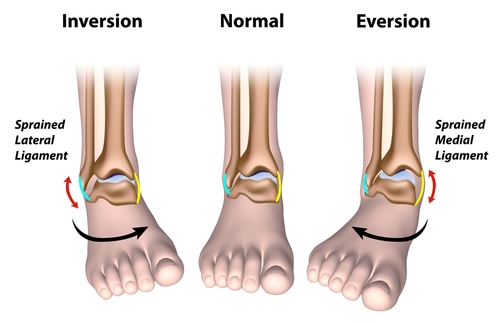Ankle Sprain
Ankle sprain is also known as ankle twist and usually involves the ankle ligament injury. Most sprained ankles involve injuries to the ligaments on the outer side of the ankle.

Symptoms and Signs
- Hematoma or Bruise
- Pain (Throbbing)
- Swelling
- Warmth
- Redness
- Inability to move the joint
Causes
Ankle sprains occur usually through excessive stress on the ligaments of the ankle. This can be caused by excessive abnormal movement of the foot caused by an external force. When the foot is moved past its range of motion, the excess stress puts a strain on the ligaments. If the strain is great enough to the ligaments past the yield point, then the ligament becomes damaged, or sprained. It can occur in sports like basketball, tennis, skating, etc.
Diagnosis
- The main diagnosis depends on the medical history and physical examination.
- X rays may help further.
- If pain is persistent for 6-8 weeks, then MRI may be considered.
Types of Ankle Sprains
- Inversion Ankle Sprain: In this the outer or lateral ligaments are stretched too much, as the foot rotates internally beyond its normal range of motion. Approximately 70–85% of ankle sprains are inversion injuries.
- Eversion Ankle Sprain: This is a less common type, affecting the medial side of the foot. In this the ankle rotates externally beyond its normal range of motion (rolls on the outside).
- High Ankle Sprain: This is an injury to the large ligaments above the ankle that join the two long bones of the lower leg, called the tibia and fibula. Sudden or forceful outward twisting of the foot causes this to occur. This commonly occurs in sports like tennis, basketball, soccer, badminton, etc.
Treatment
Generally rest and ice application helps in relieving the symptoms.
A walking boot is often used for the treatment of the sprained ankle. Braces and crutches are also used to help alleviate the pain so the injured ankle can heal as quickly and painlessly as possible.
Although found to be less effective than casts, compression bandages are used to provide support and compression for sprained ankles.
Treatment depends on the grade of injury. 95 percent on the ankle sprains are treated conservatively that is without surgery.
Surgery is indicated in the following scenarios:
- Full thickness tears of 2 ligaments of the ankle (ATFL and CFL) which have failed conservative management and complaining of recurrent episodes of instability.
- Ankle ligament repair surgery can be performed either open or arthroscopically.
- ATFL (anterior talofibular ligament) is the most common injured ligament in the ankle which helps in stabilizing the ankle ligament against an inward bending movement of the foot.
- This is the ligament most commonly repaired or reconstructed during surgery to stabilize the ankle joint.
Rehabilitation and Recovery
The purpose of rehabilitation gives the ability for the ankle to regain strength and flexibility. Many different types of rehabilitation exercises can be done to aid an ankle sprain regardless of the severity of the injury. The emphasis in the initial stages of rehabilitation should be on protecting the ankle to avoid further damage.
The key to a fast recovery is to implement all the different types of ankle sprain exercises so that the range of motion will increase while the pain is decreasing.
Physical therapists assign different types of ankle sprain exercises that deal with ankle flexibility, strengthening, balance, and agility.
To know more kindly contact the best orthopaedic surgeon Dr. Rahul Modi for further queries.
This surgery is frequently performed by the best orthopaedic surgeon Dr. Rahul Modi for treating Ankle Sprain.